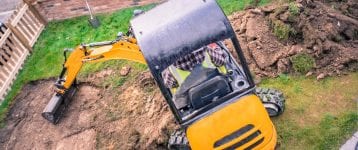Don’t put yourself in danger by ignoring excavation and trenching safety procedures
The Occupational Safety and Health Administration (OSHA) reports that the fatality rate for excavation work is 112% higher than the rate for general construction. What’s behind this sobering statistic? OSHA explains that all excavations can put you in danger because they are inherently unstable.
This governmental agency has the authority to fine companies for not following established safety procedure. It recently fined a Michigan-based contractor $454,750 for trench safety and other violations. According to OSHA, the company did not identify hazards and take corrective action when warranted. Here are the top four safety hazards associated with excavation.
1. No protective system
Excavation – especially trenching – creates restricted spaces that must use protective systems to keep workers from potentially fatal situations caused by suffocation, drowning, or being crushed by a cave-in. A competent person should evaluate the soil conditions and make sure that appropriate protective systems are put in place.
OSHA offers this appendix to identify types of soil and rock deposits. This additional appendix offers a graphic summary of the protective systems that should be used.
The National Safety Council writes that protective systems can include:
- Sloping, where the sides of the hole open out from the excavation.
- Benching, where steps are cut into the sides of the trench.
- Shoring, where wales, cross-braces, and uprights are used to support excavation walls.
- Shielding, where trench boxes or shields are placed in the excavation to prevent the sides from caving in.
You can avoid hazards by always confirming that protective systems are in place before entering an excavation site. Competent individuals should be enlisted to inspect the site daily and check for hazardous situations. Excavations should only be kept open for the minimum amount of time needed.
2. Failure to inspect protective systems
Protective systems for excavations are not check-box activities, meaning that there’s no further effort once put in place. The possibility for potential harm from cave-ins or hazardous atmospheres can happen quickly. It’s crucial that a competent person with training in soil analysis inspects the protective systems that have been selected for the excavation site. This individual should know the current OSHA requirements and have the authority to make decisions that will eliminate hazards.
These inspections are ongoing, starting even before construction begins and daily before each shift. It’s important to inspect all excavation protective systems after rain events. OSHA offers this online printable guide for daily inspection of trenches and excavations.
3. Unsafe access or egress
The most frequently cited standard following an OSHA inspection is fall protection on construction sites. Anyone in a trench or excavation site has placed themselves in danger if there’s not an apparent and safe way for access or egress. This can be accomplished with ramps, stairways, or ladders, and it’s a part of the protective system put in place.
OSHA requires a safe means of access and egress for all trenches and excavations that are deeper than four feet. These ladders, ramps, or stairways must be within 25 feet of workers. Ramps can be made of earth, but only if someone can use them by walking in an upright position.
4. Unsafe excavation placement
Excavated material – also known as spoils – that are situated too close to the edge of an excavation or trench pose a serious and potentially fatal hazard. The weight of this material could cause a cave-in. For this reason, OSHA requires that excavated material be placed at least two feet from the edge.
Depending on the type of soil, it may also be necessary to install retainers to keep this material from falling back into the excavation. Because it’s not always possible to maintain the two-foot distance requirement, OSHA requires (in that situation) that the material is moved to a different location.
If you’d like to learn more about commercial and residential excavation services, contact us at Mikla Contracting.



